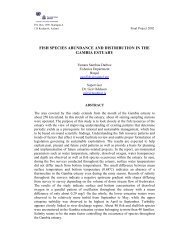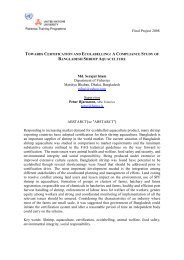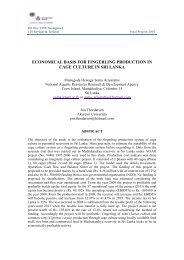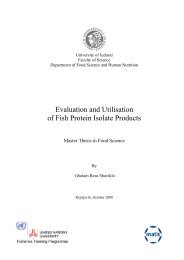Quality Indicators of Northern Shrimp (Pandalus borealis)
Quality Indicators of Northern Shrimp (Pandalus borealis)
Quality Indicators of Northern Shrimp (Pandalus borealis)
You also want an ePaper? Increase the reach of your titles
YUMPU automatically turns print PDFs into web optimized ePapers that Google loves.
Qingzhu5.6 Correlation analysisThe correlation coefficients between sensory score and other parameters are minus valuebecause the sensory scores have decreasing values with storage while the values for theother quality parameters are increasing with storage. The fact that there are very goodcorrelations between these parameters such as pH, TMA, TVB-N, TVC, NH 3 and sensoryscore illustrates that pH, NH 3 response <strong>of</strong> electronic nose measurement and sensoryevaluation, which are rapid and practical methods, can be used as quality indicators <strong>of</strong>northern shrimp. Among pH, NH 3 response <strong>of</strong> electronic nose measurement and sensoryevaluation, NH 3 response <strong>of</strong> electronic nose measurement is the best feasible qualityindicator for the shrimp because <strong>of</strong> its simple and rapid operation. Followed by pHbecause <strong>of</strong> its simple and rapid measurement although slight lower veracity. The last oneis sensory evaluation which has advantage <strong>of</strong> assessing quality with no facilities.However, the assessors who had been trained in evaluating quality <strong>of</strong> shrimp and thecharacteristic sensory attributes are needed.5.7 PCA analysisPrincipal component analysis (PCA) for all <strong>of</strong> the samples, which was conducted in thestatistical program Unscrambler (Version 7.5, CAMO ASA, Oslo, Norway), wasperformed to study the main tendencies <strong>of</strong> the variation among the measurement variableand to evaluate if the various analytical techniques applied were comparable to evaluatequality. PCA was also done to study the main trend in the data and to illustrate the effect<strong>of</strong> the different storage types on the quality and spoilage level <strong>of</strong> shrimp. Most <strong>of</strong> thelatent variables methods used in multivariate data analysis are in one way or anotherbased on PCA (Wold et al. 1987). The PCA method provides a simple and efficient wayfor graphically describing systematic variation in complex data structures. Principalcomponent analysis (PCA) is a tool for identifying relationships in complex analyticaldata by comparing data in more than one dimension. The main objective is to detectstructure in the relationship between measured parameters and experimental factors. Ithas been used to transform a number <strong>of</strong> possibly correlated variables into a (smaller)number <strong>of</strong> uncorrelated variables called principal components. The first componentexplains as much <strong>of</strong> the variability in the data as possible, then the second componentwill account for as much <strong>of</strong> the remaining variability as possible, etc.It can be seen that the first PC1 represents the quality spoilage level <strong>of</strong> the sample withthe increasing storage time from left to right along PC1 (Figure 20, 21). Group ICE/+6and S-ICE/-6, even ICE/+4 and S-ICE/-4 are located to the right in the diagram, whileLIQ/-6 is just located to the middle. The result indicates that the shrimp stored in LIQ/-tend to spoil later than the other groups, the shrimp stored in ICE/+ spoil first, and theshrimp stored in S-ICE/- spoil sooner than the others. The sample LIQ/-6 had highloadings for the salt which indicate high level <strong>of</strong> salt content in the sample. The sampleICE/+4 and ICE/+6 had high loadings for the TVC and pH value. The texture parametersmeasured in shrimp contribute very little to PC1 and do not appear to change with storagetime (Figure 21). The NH 3 response, TMA, TVB-N and TVC are located close to eachother on the plot (Figure 20, 21), illustrating that these indicators keep high correlationand give the similar information that can indicate the quality <strong>of</strong> the shrimp, the findingsUNU-Fisheries Training Programme 37
















